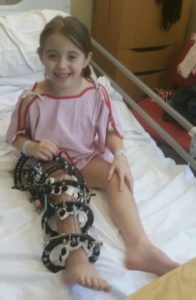Fibular Hemimelia explained
Fibular Hemimelia is a partial or total absence of the fibula and is the most common form of lower limb deficiency present at birth. There are two long bones in lower leg, the thicker one is called the tibia and the thinner one is the fibula. With Fibular Hemimelia the tibia is shorter than normal and the fibula is missing or underdeveloped. A leg affected by Fibular Hemimelia will look shorter than an unaffected leg. The tibia may be bent and the foot may also be smaller than normal, bent outwards at the ankle and may have fewer than five toes. The knee is often also misshapen and may move abnormally.
Usually only one leg is affected, with the right fibula affected more often than the left and males are 50% more likely to be affected than females.
Eilidh talks about the diagnosis and treatment of her daughter Niamh:
Diagnosis and causes
Severe cases are likely to be seen at scans during pregnancy. In milder cases it may at first be thought to be a foot deformity but when the shortening of the leg becomes more noticeable and the leg is X-rayed the full picture can be seen. Most cases of Fibular Hemimelia are thought to occur for no reason.
Steps have produced a downloadable publication, Leg Length Difference for parents who have been told of a possible problem with their baby’s legs.
How can it be treated?

Treatment will depend on the severity of the condition and how normal the foot is.
If the foot is reasonably normal it may be possible to lengthen the leg using the Ilizarov apparatus (pictured right).
If the foot is twisted outwards to the side it may be possible to correct it sufficiently using surgery.
Watch our webinar on leg lengthening below
If the foot is not sufficiently normally formed and the tibia is too short it may be best to amputate it through the ankle using procedures such as the Syme’s or Boyd amputation and fit an artificial limb (prosthesis). Prosthetic limbs can be used in almost all situations, including in water (pictured further below).
Watch our video on planned amputation
Steps have produced a Parent’s Guide to Planned Amputation to help parents and carers prepare themselves and their child for a lower limb amputation.
Steps have also produced a guide – Preparing For Your Child’s Surgery to help parents and carers prepare themselves and their child for a hospital admission.
Steps have produced a fact sheet about emotionally Preparing for an Amputation with further publications on preparing for hospital, life with a prosthetic and talking to education providers available in the near future.
In cases where the fibula is present and the shortening is not severe the treatment is usually leg equalisation either by slowing growth of the other leg (epiphyseodesis) or leg lengthening.
Laila’s parent’s talk about their choice of treatment:
Children’s sports prostheses funding in England

The Department of Health and Social Care is making £1 million available (£500,000 per financial year) to fund prostheses in England. The fund is for children who have suffered limb loss or were born with a limb deficiency, to enable them to take part in physical activity and sports. The funding is available until the end of March 2020.
NHS limb centres in England may request funds for individual prostheses they have prescribed up to the value of £5,000 per limb (not per child). This includes all the associated costs of fitting the new limb, such as a new socket or liner.
For an individual prosthesis of greater value, they must apply for approval from an advisory group.
Steps is a member of the advisory group and if you have any questions on funding for sports prostheses please contact us on info@steps-charity.org.uk.
